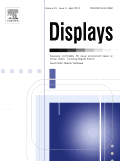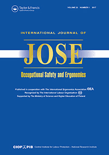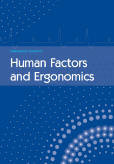
INTERNATIONAL JOURNAL OF INDUSTRIAL ERGONOMICS
Scope & Guideline
Fostering insights that bridge science and practice.
Introduction
Aims and Scopes
- Human-Computer Interaction and User Experience:
The journal emphasizes the design and evaluation of user interfaces and interactions, exploring how ergonomic principles can improve user experience and task performance in industrial settings. - Workplace Ergonomics and Safety:
Research on optimizing workplace design to reduce injury risk and enhance worker safety is a core focus, examining factors such as posture, equipment design, and environmental influences. - Cognitive Ergonomics and Human Factors:
The journal explores cognitive aspects of ergonomics, including workload assessment, situation awareness, and decision-making processes in complex work environments. - Biomechanics and Physical Ergonomics:
Studies investigating the physical interactions between humans and their tasks, including musculoskeletal disorders, body mechanics, and the effects of physical loads on performance. - Technology and Ergonomic Design:
The integration of emerging technologies, such as virtual reality and artificial intelligence, in ergonomic assessments and interventions is a significant area of interest.
Trending and Emerging
- Wearable Technology and Smart Devices:
An increasing number of studies are focusing on the application of wearable devices for monitoring ergonomic risks and enhancing worker safety, reflecting a trend towards real-time data collection and analysis. - Virtual Reality and Simulation Training:
Research on the use of virtual reality for training and ergonomic assessments is on the rise, indicating a growing interest in immersive technologies to simulate work environments and improve learning outcomes. - Personalized Ergonomics and User-Centric Design:
There is a trend towards tailoring ergonomic interventions based on individual characteristics, such as body shape and personal preferences, to enhance usability and comfort. - Mental Health and Ergonomics:
Emerging studies are increasingly addressing the psychological aspects of ergonomics, including stress, cognitive load, and their impact on worker performance and well-being. - Interdisciplinary Approaches to Ergonomics:
The integration of insights from fields such as psychology, engineering, and data science into ergonomic research is becoming more prevalent, fostering innovative solutions to complex ergonomic challenges.
Declining or Waning
- Traditional Ergonomic Assessments:
There is a noticeable reduction in studies focusing solely on traditional ergonomic assessment methods such as RULA and REBA, as newer, more integrated approaches gain traction. - Static Posture Analysis:
Research centered on static posture analysis has decreased, as there is a growing emphasis on dynamic and situational factors that affect ergonomics in real-world tasks. - Generalized Workplace Studies:
The prevalence of broad, generalized studies on workplace ergonomics is waning, with a shift towards more specific, context-driven research that addresses unique industry challenges. - Classic Human Factors Models:
The use of classic human factors models appears to be declining, as researchers move towards more complex, nuanced frameworks that account for the interplay of multiple variables in human-system interactions.
Similar Journals

DISPLAYS
Advancing the Future of Display TechnologyDISPLAYS is a prestigious journal published by Elsevier that focuses on the dynamic intersection of Electrical and Electronic Engineering, Hardware and Architecture, and Human-Computer Interaction. Since its inception in 1979, the journal has made significant contributions to advancing the field, currently holding a notable impact factor and ranking within the Q2 category across multiple disciplines, including Electrical and Electronic Engineering, Hardware and Architecture, and Human-Computer Interaction. With its broad scope, DISPLAYS is dedicated to publishing high-quality research that inspires innovation in display technology and its applications. Researchers and professionals benefit from access to cutting-edge findings in the realm of display systems, which are integral to the evolving landscape of digital interaction. Operating without an open access option, the journal ensures rigorous peer review, maintaining the highest standards of academic integrity and research quality. Positioned in the heart of the Netherlands, DISPLAYS continues to play a critical role in shaping future advancements, making it an essential read for anyone committed to these vital fields of study.

ACM Transactions on Applied Perception
Pioneering Research at the Crossroads of Psychology and ComputingACM Transactions on Applied Perception is a leading journal published by the Association for Computing Machinery, focusing on the intersection of perception science and computational methods. With an ISSN of 1544-3558 and an E-ISSN of 1544-3965, this esteemed publication has been a vital resource for innovators and researchers since its establishment in 2004. It operates within the ambit of Computer Science and the realms of Experimental and Cognitive Psychology, boasting a commendable impact factor and category rankings, including Q2 in Computer Science (miscellaneous) and Q3 in both Experimental and Cognitive Psychology and Theoretical Computer Science. The journal's scope encompasses a plethora of studies aimed at understanding human perception through computational lenses, making it an essential platform for scholarly exchange. Although it does not currently offer an Open Access option, its extensive reach and rigorous peer-review process ensure high visibility and impact in the academic community. By fostering collaboration across disciplines, ACM Transactions on Applied Perception encourages advancements that bridge perceptual research with practical applications, making it invaluable for researchers, professionals, and students engaged in this dynamic field.

International Journal of Occupational Safety and Ergonomics
Pioneering insights for a safer, more ergonomic future.International Journal of Occupational Safety and Ergonomics, ISSN 1080-3548, is a leading multidisciplinary journal published by TAYLOR & FRANCIS LTD with a dedicated focus on advancing research and practices in occupational safety and ergonomics. Since its inception in 1995, this journal has provided a platform for the dissemination of innovative studies that address critical issues in public health, environmental and occupational health, and safety research. Recognized for its rigorous peer-review process, the journal holds a respectable position in the Q2 quartile rankings across multiple categories as of 2023, reflecting its impact and relevance within the academic community. It ranks 24th out of 109 in Safety Research, 198th out of 665 in Public Health, and 66th out of 207 in Safety, Risk, Reliability and Quality, showcasing its influence in these essential fields. The journal's broad scope aims to bridge gaps between research and application, ensuring that findings contribute to effective safety practices in various industries. While not an Open Access journal, the International Journal of Occupational Safety and Ergonomics remains an invaluable resource for researchers, professionals, and students seeking to stay informed about the evolving landscape of occupational safety. Its headquarters are located in Abingdon, England, serving as a conduit for scholarly communication in this vital area of study.

Multimodal Technologies and Interaction
Connecting Disciplines for Cutting-Edge Interaction.Multimodal Technologies and Interaction, published by MDPI since 2017, is an esteemed open-access journal based in Switzerland, dedicated to the exploration and advancement of innovative multimodal systems that enhance user experience across various digital platforms. With its commitment to disseminating high-quality research in diverse areas such as Computer Networks and Communications, Human-Computer Interaction, and Neuroscience, the journal has rapidly established itself within the academic community, achieving a commendable position in Scopus rankings including Q2 in both Computer Networks and Communications and Computer Science Applications. As an essential resource for researchers, professionals, and students alike, Multimodal Technologies and Interaction fosters interdisciplinary dialogue and supports the development of cutting-edge technologies, ensuring that advancements in multimodal interaction are accessible to a global audience. Scholars can benefit from its Open Access format, allowing unrestricted access to influential studies that shape the future of technology and interaction design.

Indian Journal of Occupational and Environmental Medicine
Innovating Practices for Occupational Safety and Environmental Well-beingIndian Journal of Occupational and Environmental Medicine, published by Wolters Kluwer Medknow Publications, is a pivotal resource in the field of public health, focusing on the critical intersections of occupational safety and environmental health. With the ISSN 0973-2284 and E-ISSN 1998-3670, this journal has been a beacon of knowledge since its inception in 1999 and continues to influence scholarly discourse through its convergence years culminating in 2024. Recognized for its contribution to the field with a 2023 Scopus categorization of Q3 in Public Health, Environmental and Occupational Health, it has secured its place among the top journals, ranked #453 out of 665 within its specialty, reflecting a respectable 31st percentile. While it operates on a subscription basis, the journal ensures comprehensive coverage of significant research, thereby enhancing occupational health practices and environmental health policies. It serves as a vital platform for researchers, professionals, and students dedicated to advancing knowledge and improving outcomes in these crucial areas of health. The journal's commitment to excellence is evident as it continues to cater to a diverse readership from its base in Mumbai, India.

MM Science Journal
Advancing Engineering Excellence, One Article at a Time.MM Science Journal is a leading publication in the fields of Automotive Engineering, Electrical and Electronic Engineering, Industrial and Manufacturing Engineering, and Mechanical Engineering, published by MM SCIENCE. Established in 2014 and spanning a converged period to 2024, this journal serves as a crucial platform for disseminating innovative research and practical applications relevant to industry professionals and academic scholars alike. With a notable Q3 ranking in multiple engineering categories and Scopus Ranks placing it in the 35th to 25th percentiles across various disciplines, MM Science Journal is committed to advancing knowledge and fostering collaboration in engineering disciplines. Although not currently an open-access publication, the journal remains instrumental for those seeking to engage with cutting-edge developments in engineering from its base in the Czech Republic. Researchers, students, and professionals are encouraged to explore the rich findings shared within its pages, contributing to the ongoing evolution of engineering practices.

International Journal of Human Factors and Ergonomics
Empowering Research to Transform User ExperiencesWelcome to the International Journal of Human Factors and Ergonomics, a premier platform dedicated to the exploration and advancement of research in the increasingly vital fields of human factors and ergonomics. Published by INDERSCIENCE ENTERPRISES LTD, this journal serves an international audience of researchers, practitioners, and students, facilitating the dissemination of knowledge that aims to enhance the interaction between people and systems. With its ISSN 2045-7804 and E-ISSN 2045-7812, the journal actively contributes to the academic community's understanding of human capabilities and limitations, striving to improve product design, work environments, and overall usability. Despite its classification in Q4 of the 2023 Human Factors and Ergonomics category and a Scopus ranking reflecting the competitive landscape—where it stands at #37 out of 46 in its field—the journal is committed to building a strong foundation of evidence-based practices through rigorous peer-reviewed articles. Through its convergence efforts from 2016 to 2024, it aims to bridge theoretical research with practical applications to promote safety, efficiency, and user satisfaction across various domains.

HUMAN-COMPUTER INTERACTION
Transforming User Experience Through ResearchHUMAN-COMPUTER INTERACTION is a premier academic journal published by Taylor & Francis Inc, dedicated to the interdisciplinary field of HCI, which explores the dynamic interactions between humans and computers. With its ISSN 0737-0024 and E-ISSN 1532-7051, the journal maintains a strong presence within the academic community and is recognized for its significant impact, holding a commendable impact factor that underscores its relevance. Ranked in the Q1 category for both Applied Psychology and Human-Computer Interaction, it occupies a critical position in Scopus rankings, listed as #15 in Applied Psychology and #11 in Computer Science, Human-Computer Interaction, placing it in the top 6% of relevant fields. Covering a broad spectrum of topics from usability studies to user experience design, the journal aims to facilitate innovative research and provide insights that bridge theoretical frameworks and practical applications. Published since 1985 and continuously evolving, HUMAN-COMPUTER INTERACTION remains an essential resource for researchers, professionals, and students eager to contribute to and benefit from advances in understanding how technology can effectively serve human needs.

Cognition Technology & Work
Exploring the Intersection of Mind and MachineCognition Technology & Work, published by SPRINGER LONDON LTD, is a premier journal dedicated to exploring the multifaceted interactions between cognitive processes and technological applications in various work environments. With an ISSN of 1435-5558 and an E-ISSN of 1435-5566, this journal has established itself as a critical resource for scholars and practitioners in the fields of Computer Science, Human-Computer Interaction, and Philosophy. Evaluated in the 2023 Journal Citation Reports, it holds impressive category quartiles, ranking Q2 in Computer Science Applications and Human-Computer Interaction, and Q1 in Philosophy, highlighting its significant impact in academic discourse. Furthermore, its Scopus rankings showcase its robust standing, particularly within the Arts and Humanities and Computer Science sectors. Adopting a rigorous peer-review process, the journal aims to foster scholarly communication and advancement in the understanding of cognitive influences on technology in the workplace. It serves as an essential platform for researchers, professionals, and students alike, providing insight into innovative methodologies and theoretical frameworks that shape the future of cognitive technology in work settings.

SAFETY SCIENCE
Pioneering research in safety and risk management.SAFETY SCIENCE, published by Elsevier in the Netherlands, is a premier international journal dedicated to advancing the fields of safety research, public health, environmental and occupational health, and risk management. With an impressive impact factor and recognized as a Q1 journal in multiple categories for 2023, its rigorous peer-reviewed articles are essential for researchers, professionals, and students alike. The journal covers a wide range of topics designed to influence safety practices and policies globally. Although Open Access options are not available, the substantial insights provided in each issue underscore the journal's critical role in enhancing the understanding of safety and risk dynamics in a constantly evolving world. With a convergence of knowledge from the years 1991 to 2025, SAFETY SCIENCE remains at the forefront of evidence-based research, stimulating essential dialogues and innovations that shape our approach to safety in various domains.